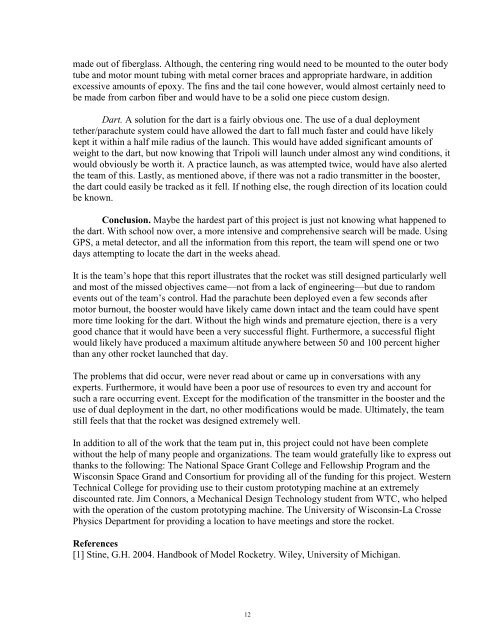Space Grant Consortium - University of Wisconsin - Green Bay
Space Grant Consortium - University of Wisconsin - Green Bay
Space Grant Consortium - University of Wisconsin - Green Bay
Create successful ePaper yourself
Turn your PDF publications into a flip-book with our unique Google optimized e-Paper software.
made out <strong>of</strong> fiberglass. Although, the centering ring would need to be mounted to the outer body<br />
tube and motor mount tubing with metal corner braces and appropriate hardware, in addition<br />
excessive amounts <strong>of</strong> epoxy. The fins and the tail cone however, would almost certainly need to<br />
be made from carbon fiber and would have to be a solid one piece custom design.<br />
Dart. A solution for the dart is a fairly obvious one. The use <strong>of</strong> a dual deployment<br />
tether/parachute system could have allowed the dart to fall much faster and could have likely<br />
kept it within a half mile radius <strong>of</strong> the launch. This would have added significant amounts <strong>of</strong><br />
weight to the dart, but now knowing that Tripoli will launch under almost any wind conditions, it<br />
would obviously be worth it. A practice launch, as was attempted twice, would have also alerted<br />
the team <strong>of</strong> this. Lastly, as mentioned above, if there was not a radio transmitter in the booster,<br />
the dart could easily be tracked as it fell. If nothing else, the rough direction <strong>of</strong> its location could<br />
be known.<br />
Conclusion. Maybe the hardest part <strong>of</strong> this project is just not knowing what happened to<br />
the dart. With school now over, a more intensive and comprehensive search will be made. Using<br />
GPS, a metal detector, and all the information from this report, the team will spend one or two<br />
days attempting to locate the dart in the weeks ahead.<br />
It is the team’s hope that this report illustrates that the rocket was still designed particularly well<br />
and most <strong>of</strong> the missed objectives came—not from a lack <strong>of</strong> engineering—but due to random<br />
events out <strong>of</strong> the team’s control. Had the parachute been deployed even a few seconds after<br />
motor burnout, the booster would have likely came down intact and the team could have spent<br />
more time looking for the dart. Without the high winds and premature ejection, there is a very<br />
good chance that it would have been a very successful flight. Furthermore, a successful flight<br />
would likely have produced a maximum altitude anywhere between 50 and 100 percent higher<br />
than any other rocket launched that day.<br />
The problems that did occur, were never read about or came up in conversations with any<br />
experts. Furthermore, it would have been a poor use <strong>of</strong> resources to even try and account for<br />
such a rare occurring event. Except for the modification <strong>of</strong> the transmitter in the booster and the<br />
use <strong>of</strong> dual deployment in the dart, no other modifications would be made. Ultimately, the team<br />
still feels that that the rocket was designed extremely well.<br />
In addition to all <strong>of</strong> the work that the team put in, this project could not have been complete<br />
without the help <strong>of</strong> many people and organizations. The team would gratefully like to express out<br />
thanks to the following: The National <strong>Space</strong> <strong>Grant</strong> College and Fellowship Program and the<br />
<strong>Wisconsin</strong> <strong>Space</strong> Grand and <strong>Consortium</strong> for providing all <strong>of</strong> the funding for this project. Western<br />
Technical College for providing use to their custom prototyping machine at an extremely<br />
discounted rate. Jim Connors, a Mechanical Design Technology student from WTC, who helped<br />
with the operation <strong>of</strong> the custom prototyping machine. The <strong>University</strong> <strong>of</strong> <strong>Wisconsin</strong>-La Crosse<br />
Physics Department for providing a location to have meetings and store the rocket.<br />
References<br />
[1] Stine, G.H. 2004. Handbook <strong>of</strong> Model Rocketry. Wiley, <strong>University</strong> <strong>of</strong> Michigan.<br />
12

















